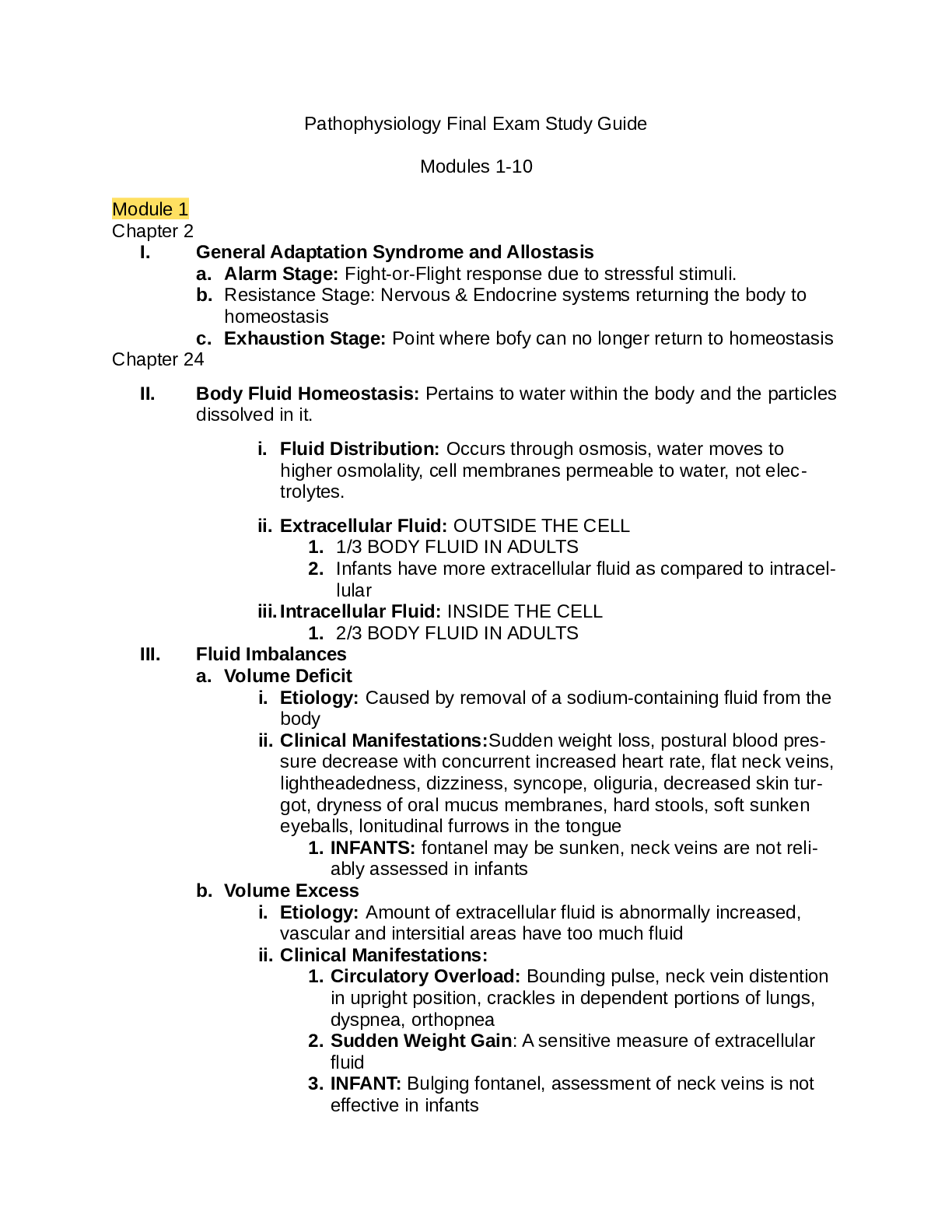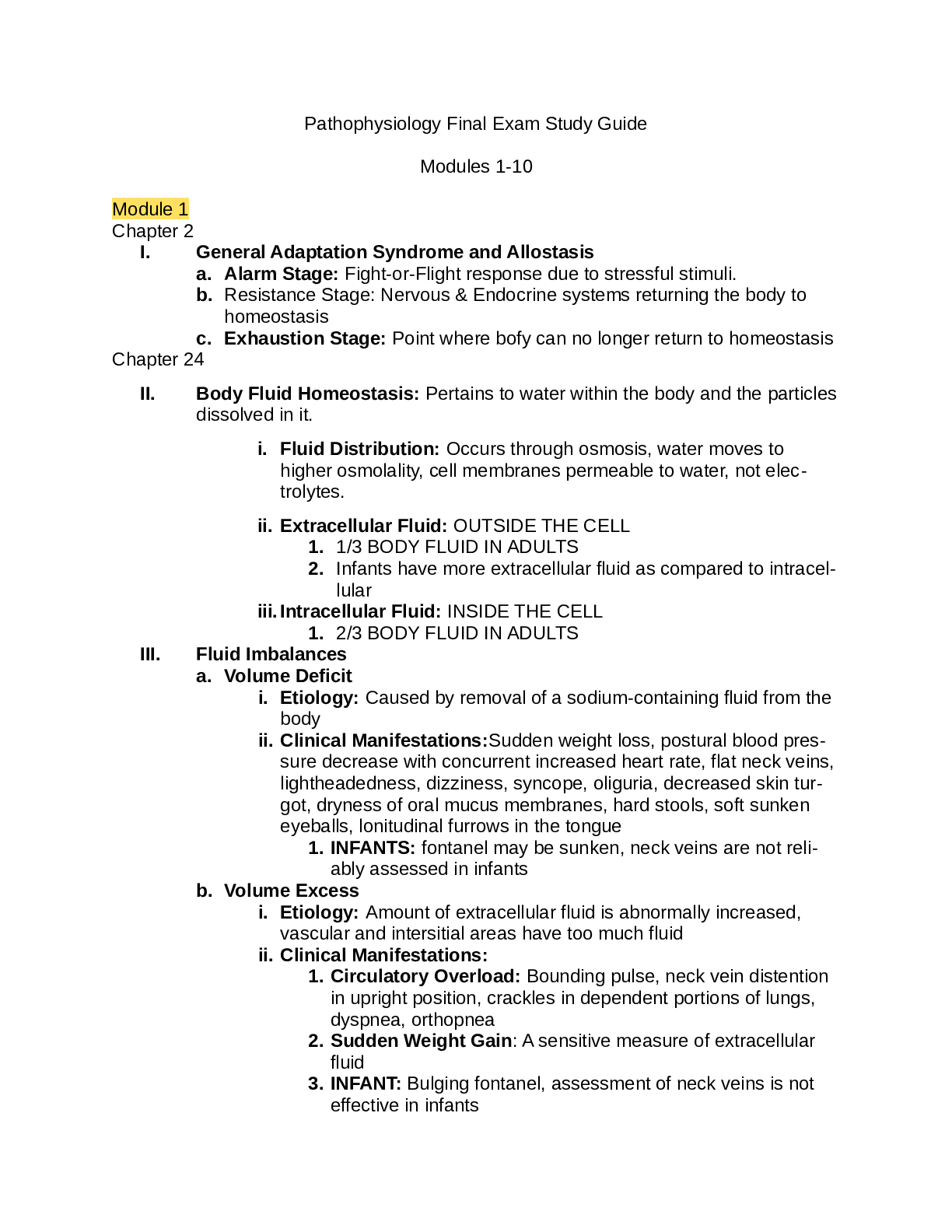Module 1
Chapter 2
I. General Adaptation Syndrome and Allostasis
a. Alarm Stage: Fight-or-Flight response due to stressful stimuli.
b. Resistance Stage: Nervous & Endocrine systems returning the body to
homeostasis
c. Exhaustion Stage: Point where bofy can no longer return to homeostasis
Chapter 24
II. Body Fluid Homeostasis: Pertains to water within the body and the particles
dissolved in it.
i. Fluid Distribution: Occurs through osmosis, water moves to
higher osmolality, cell membranes permeable to water, not electrolytes.
ii. Extracellular Fluid: OUTSIDE THE CELL
1. 1/3 BODY FLUID IN ADULTS
2. Infants have more extracellular fluid as compared to intracellular
iii.Intracellular Fluid: INSIDE THE CELL
1. 2/3 BODY FLUID IN ADULTS
III. Fluid Imbalances
a. Volume Deficit
i. Etiology: Caused by removal of a sodium-containing fluid from the
body
ii. Clinical Manifestations:Sudden weight loss, postural blood pressure decrease with concurrent increased heart rate, flat neck veins,
lightheadedness, dizziness, syncope, oliguria, decreased skin turgot, dryness of oral mucus membranes, hard stools, soft sunken
eyeballs, lonitudinal furrows in the tongue
1. INFANTS: fontanel may be sunken, neck veins are not reliably assessed in infants
b. Volume Excess
i. Etiology: Amount of extracellular fluid is abnormally increased,
vascular and intersitial areas have too much fluid
ii. Clinical Manifestations:
1. Circulatory Overload: Bounding pulse, neck vein distention
in upright position, crackles in dependent portions of lungs,
dyspnea, orthopnea
2. Sudden Weight Gain: A sensitive measure of extracellular
fluid
3. INFANT: Bulging fontanel, assessment of neck veins is not
effective in infants
4. Edema
5. ADVANCED: Frothy sputum of pulmonary edema
IV. Body Fluid Concentration
a. Hyponatremia: Serum Sodium conentration below the lower limit of nor�mal
i. Clinical Manifestations:
1. Mild Central Nervous System Dysfunction: Malaise,
anorexia, nausea, vommiting, headache
2. Severe Central Nervous System Dysfunction: Confusion,
lethargy, seizures, coma, fatal cerebral herniation
b. Hypernatremia: Serum sodium concentration above upper limit of normal
i. Etiology/Causes: Gain of more salt than water, loss of more water
than salt
c. Interstitial Fluid Volume
i. Edema:
V. Electrolyte Imbalances
a. Serum Potassium
i. Hypokalemia: decreased potassium ion concentration in extracel�lular fluid
1. Etiology:
a. Decreased Intake: Usually in conditions that cause a
decreased oral intake
b. Shift into the cell from extracellular fluid
c. Increased Excretion: Renal, through feces, Sweat,
GI Tract (Emesis, diarrhea) Diuretics
ii. Hyperkalemia: Rise of serum potassium levels above 5 MEQ/L
1. Clinical Manifestations:
a. Early, Mild: Intesional Cramping, Diarrhea
b. Late, More severe: Musclue weakness: (Ascending,
beginning in lower extremities) Cardiac Dysrhythmias,
even cardiac arrest
b. Serum Calcium
i. Clinical manifestations:
1. HYPO�a. Clinical Manifestations:
i. Hyperexcitability of Neuromuscular cells:
possitive trousseau sign, positive chvostek sign
(not reliable in infants), parethesias, muscle
twitching and cramping, hyperactive reflexes,
carpal spasm, pedal spasm, tetany, laryn�gospasm, seizures, cardiac dyshythmias
2. HYPER-
Read More


